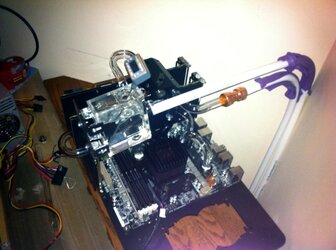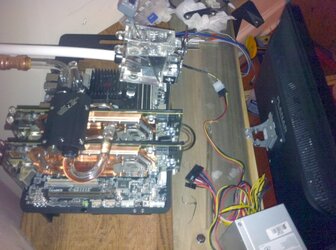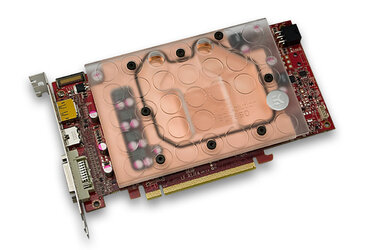- Joined
- Feb 21, 2008
- Location
- Baltimore, MD
So i was thinking about this recently. I'm planning to rebuild my HTPC (board, cpu, ram). and wanted to over clock it a good bit. so i was initially debating between an AIO cooler, or just making a custom loop.
Antec Fusion Remote
i7-7700k 4.2GHz (shooting for 5GHz, but i wont be crushed if i'm short)
ASUS STRIX Z270G GAMING
my major hangup is available space.the case is totally partitioned around the mATX board with no extra space. I'm using, and quite like my Antec Fusion Remote case so I'm not planning to change cases. I've already modded it a bit to fit my long graphics card, so i'm not scared to cut it some more. Also, i quickly realized that a custom build would be much more expensive. I'll preface this that for my initial purposes, I decided to just go with the EVGA CLC-240 AIO unit https://www.evga.com/articles/01081/evga-clc-liquid-cpu-cooler/ . i need to cut the case a bit, but it should still be pretty clean looking. and the EVGA unit is very aesthetic compared to other offerings (sans the NZXT, but its more $$).
But I'm still interested in this concept. I've been reading some discussions as obviously I'm not the first to have this idea. I mean all (most) AIO units are like this, so why can't i make my own? I might do this in the future just for the hell of it and proof of concept.
Basically for a CPU only loop, i think it would be quite simple.
$145 - Apogee Drive II
$50+ -whatever radiator you want (i was looking into 240mm size)
$20+ -fittings (could go up if you get fancy)
$10+ -tubing (not much needed for an "AOI" CPU-only setup)
so maybe 2-3x the price of a standard AIO kit, granted with better expandability and more quality components.
so it seems the biggest issue people come up with for why you shouldnt do this is filling and bleeding the system, and the worry that trapped air would degrade lifespan of the pump (i think this is highly exaggerated). the best case would be to make it totally free from air in the loop, then somehow seal it without introducing more air.
I was thinking to do it like this:
get large enough container to totally submerge the radiator, laid flat, fittings up.
fill container with your fluid (distilled + biocide is sufficient, IMO) above the height of the radiator
connect tubing between drive and rad, but leave one tube disconnected from the rad and instead submerged in the pool of fluid
run pump until there are no more bubbles. the rad in this position isnt likely to trap many bubbles.
move things around a bit to jostle whatever bubbles might exist in the pump/block or rad.
leave setup to run for a few hours
connect/seal the open tube/rad line while keeping both submerged so no air gets introduced.
remove whole setup from "pool" and let dry.
yeah you'll waste a bunch of water doing this, but distilled water is cheap so who cares?.
now you should have basically a whole AIO setup, with quality components and no need for extra space for a res or pump.
thoughts?
Antec Fusion Remote
i7-7700k 4.2GHz (shooting for 5GHz, but i wont be crushed if i'm short)
ASUS STRIX Z270G GAMING
my major hangup is available space.the case is totally partitioned around the mATX board with no extra space. I'm using, and quite like my Antec Fusion Remote case so I'm not planning to change cases. I've already modded it a bit to fit my long graphics card, so i'm not scared to cut it some more. Also, i quickly realized that a custom build would be much more expensive. I'll preface this that for my initial purposes, I decided to just go with the EVGA CLC-240 AIO unit https://www.evga.com/articles/01081/evga-clc-liquid-cpu-cooler/ . i need to cut the case a bit, but it should still be pretty clean looking. and the EVGA unit is very aesthetic compared to other offerings (sans the NZXT, but its more $$).
But I'm still interested in this concept. I've been reading some discussions as obviously I'm not the first to have this idea. I mean all (most) AIO units are like this, so why can't i make my own? I might do this in the future just for the hell of it and proof of concept.
Basically for a CPU only loop, i think it would be quite simple.
$145 - Apogee Drive II
$50+ -whatever radiator you want (i was looking into 240mm size)
$20+ -fittings (could go up if you get fancy)
$10+ -tubing (not much needed for an "AOI" CPU-only setup)
so maybe 2-3x the price of a standard AIO kit, granted with better expandability and more quality components.
so it seems the biggest issue people come up with for why you shouldnt do this is filling and bleeding the system, and the worry that trapped air would degrade lifespan of the pump (i think this is highly exaggerated). the best case would be to make it totally free from air in the loop, then somehow seal it without introducing more air.
I was thinking to do it like this:
get large enough container to totally submerge the radiator, laid flat, fittings up.
fill container with your fluid (distilled + biocide is sufficient, IMO) above the height of the radiator
connect tubing between drive and rad, but leave one tube disconnected from the rad and instead submerged in the pool of fluid
run pump until there are no more bubbles. the rad in this position isnt likely to trap many bubbles.
move things around a bit to jostle whatever bubbles might exist in the pump/block or rad.
leave setup to run for a few hours
connect/seal the open tube/rad line while keeping both submerged so no air gets introduced.
remove whole setup from "pool" and let dry.
yeah you'll waste a bunch of water doing this, but distilled water is cheap so who cares?.
now you should have basically a whole AIO setup, with quality components and no need for extra space for a res or pump.
thoughts?



